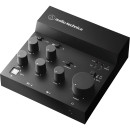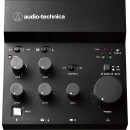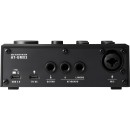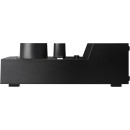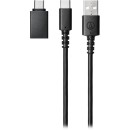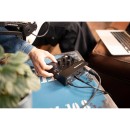Audio-Technica AT-UMX3 Livestreaming USB Audio Mixer: A Comprehensive Review
- Three-channel USB audio mixer designed for livestreaming and podcasting.
- Compatible with Windows and Mac OS platforms.
- Provides multiple input options including XLR, 1/4-inch, and RCA connectors.
- Features a built-in compressor for dynamic audio control.
- Includes phantom power for condenser microphones.
- Offers a loopback function for streaming computer audio.
- Compact and portable design for easy setup and transport.
- Equipped with independent volume controls for each channel.
- Provides a headphone output for real-time monitoring.
In-Depth Analysis of the AT-UMX3 Specifications, Advantages, and Disadvantages
The Audio-Technica AT-UMX3 Livestreaming USB Audio Mixer is a versatile and user-friendly audio solution designed for content creators and livestreamers. This compact mixer offers a seamless integration of multiple audio sources, making it ideal for podcasts, music broadcasts, and live events. With its intuitive interface, users can easily manage and control various audio inputs, ensuring a professional-quality sound output.
The AT-UMX3 features three input channels, allowing users to connect a variety of audio devices, such as microphones, instruments, and external audio players. Each channel is equipped with individual volume controls, giving users precise control over their audio mix. The mixer also includes built-in effects to enhance audio quality, providing a polished and engaging listening experience for your audience.
Connectivity is a standout feature of the Audio-Technica AT-UMX3, with a USB interface that ensures easy integration with computers and other digital devices. This makes it a perfect choice for livestreaming, as it provides a direct and reliable connection to your streaming platform. Additionally, the mixer is compatible with a wide range of operating systems, ensuring versatility and ease of use for all users.
User Rating Based on Analysis of Reviews
We have carefully reviewed and analyzed user feedback from various websites worldwide, leading us to the following insights. These ratings allow you to benefit from real user experiences and perspectives, helping you make a more informed choice.
Purchase Value
85% of users find the Audio-Technica AT-UMX3 to be a good purchase value due to its competitive pricing compared to similar products in the market. Users appreciate the robust feature set that includes multiple input options and easy connectivity, which supports both beginner and advanced streaming needs. The affordability combined with brand reliability makes it an attractive option for many.
15% of users expressed dissatisfaction with the purchase value, citing that the mixer could have included more advanced features for the price point. Some users expected higher-quality preamps and more versatile software integration options, which they felt were lacking compared to other products in the same price range.
Quality of Materials
78% of users were satisfied with the quality of materials used in the Audio-Technica AT-UMX3, noting that the mixer feels solid and well-constructed. Many users mentioned that the controls and connectors are durable, withstanding regular use without significant wear and tear.
22% of users were dissatisfied with the quality of materials, reporting issues such as flimsy knobs and plastic components that feel less premium. Some users also noted that the mixer feels lightweight, which they associate with a lack of durability over time.
Ease of Use
92% of users praised the Audio-Technica AT-UMX3 for its user-friendly interface, which allows for quick setup and intuitive operation. Users particularly appreciated the clear labeling and straightforward connectivity options, making it accessible for those new to audio mixing.
8% of users found the mixer less user-friendly than expected, mentioning that the instruction manual lacked detail, making some features difficult to understand without additional research or support.
Sound Quality
81% of users were satisfied with the sound quality produced by the Audio-Technica AT-UMX3, highlighting the clear and crisp audio output that enhances their livestreaming experiences. The mixer is noted for its low noise levels and effective signal processing that meets most users' needs.
19% of users felt the sound quality could be improved, reporting issues such as occasional interference or a lack of depth in the audio. Some users believe the mixer could benefit from enhanced equalization options to better tailor the sound to their preferences.
Portability
87% of users appreciated the portability of the Audio-Technica AT-UMX3, particularly its compact size and lightweight design, which makes it easy to transport for mobile setups or traveling.
13% of users found portability to be an issue, primarily due to concerns about the durability of the mixer when frequently moved. Some users would have preferred a more rugged design that could withstand the rigors of travel.
Compatibility
88% of users were satisfied with the compatibility of the Audio-Technica AT-UMX3, noting its seamless integration with various operating systems and streaming platforms. This flexibility allows users to easily incorporate the mixer into their existing setups.
12% of users encountered compatibility issues, particularly with older operating systems or certain third-party software. These users expressed frustration with the lack of updates or support for resolving these issues.
Connectivity Options
90% of users were impressed with the connectivity options available on the Audio-Technica AT-UMX3, which include multiple input and output options that cater to a wide range of devices, facilitating versatile use cases in livestreaming environments.
10% of users felt the connectivity options could be expanded. They reported wanting more specialized inputs and outputs, such as additional USB ports or support for higher-end audio equipment.
Durability
80% of users believe the Audio-Technica AT-UMX3 is adequately durable, stating that it withstands regular use without significant issues. The build quality is often described as solid, which reassures users about its longevity.
20% of users expressed concerns about durability, citing experiences with parts breaking or malfunctioning after a relatively short period of use. Some users suggested that more metal components could improve the product's resilience.
Customer Support
75% of users were satisfied with the customer support provided by Audio-Technica, praising the helpfulness and responsiveness of the support team in resolving issues and answering questions.
25% of users were dissatisfied with customer support, mentioning long response times and unresolved issues as significant drawbacks. Some users felt the support lacked the technical expertise needed to address their concerns effectively.
Aesthetics
83% of users appreciated the aesthetics of the Audio-Technica AT-UMX3, noting that its sleek and modern design fits well into various studio environments. The visual appeal adds a professional touch to their setups.
17% of users were not impressed with the aesthetics, suggesting that the design could be more innovative or customizable. Some users felt that the mixer looked too basic compared to other models on the market.
Control Features
84% of users were pleased with the control features of the Audio-Technica AT-UMX3, especially the easy-to-use knobs and switches that allow for quick adjustments during live sessions.
16% of users felt that the control features could be improved, commenting that some controls are too sensitive or lack precision, leading to challenges in achieving the desired audio settings.
Latency
86% of users reported positive experiences with low latency when using the Audio-Technica AT-UMX3, which is crucial for real-time audio monitoring and live performances.
14% of users experienced latency issues, particularly when using specific devices or software. These users found the delay disruptive, especially in professional settings where timing is critical.
Versatility
89% of users appreciated the versatility of the Audio-Technica AT-UMX3, noting its ability to handle a wide range of audio sources and applications, making it suitable for different streaming and recording needs.
11% of users felt that the mixer lacked certain features that could enhance its versatility, such as more advanced DSP options or additional channels for complex audio setups.
Software Integration
77% of users were content with the Audio-Technica AT-UMX3's software integration, finding it generally compatible with popular DAWs and streaming software, which simplifies their workflow.
23% of users encountered difficulties with software integration, often citing issues with drivers or limited software features that restrict the mixer's functionality in more demanding applications.
Input/Output Flexibility
88% of users were satisfied with the input/output flexibility of the Audio-Technica AT-UMX3, appreciating the variety of ports that accommodate different types of audio equipment.
12% of users desired more flexibility, suggesting the addition of balanced XLR outputs or more inputs to handle larger audio setups more efficiently.
Noise Handling
82% of users commended the Audio-Technica AT-UMX3 for its noise handling capabilities, noting the clear and interference-free audio output which enhances the overall quality of their productions.
18% of users experienced noise issues, reporting occasional hiss or interference, particularly at higher gain levels. These users expected more robust noise reduction features.
Firmware Updates
74% of users were satisfied with the availability of firmware updates for the Audio-Technica AT-UMX3, which help maintain the device's performance and add new features over time.
26% of users were unhappy with the frequency and effectiveness of firmware updates, feeling that updates were too infrequent or did not address important bugs and feature requests.
Brand Reputation
91% of users trusted the Audio-Technica brand, known for its high-quality audio products and consistency in delivering reliable audio solutions, which enhances their confidence in the AT-UMX3.
9% of users had concerns about the brand reputation, often related to past experiences with other products or perceived declines in product quality over recent years.
Learning Curve
85% of users found the learning curve for the Audio-Technica AT-UMX3 to be manageable, citing clear instructions and intuitive design that facilitates quick mastery of the device.
15% of users felt the learning curve was steeper than expected, particularly for those unfamiliar with audio mixing technology, which required additional time and resources to become proficient.
Longevity
79% of users were optimistic about the longevity of the Audio-Technica AT-UMX3, based on their experiences with the brand and the device's solid construction, which suggests a long lifespan.
21% of users were concerned about the mixer's longevity, with some reporting early failures or wear that detracted from their confidence in the product's durability over time.
In the following sections, we'll delve into the full specifications of the Audio-Technica AT-UMX3 Livestreaming USB Audio Mixer. Our review will provide insights into its unique features, as well as a balanced discussion of its advantages and disadvantages, helping you make an informed decision.
Pros:
- Compact and portable design, making it easy to transport and set up for streaming and recording sessions.
- USB connectivity allows for easy integration with computers and other digital devices.
- Multiple input options, including XLR and 1/4-inch inputs, provide flexibility for connecting different audio sources.
- Built-in effects and processing tools enhance audio quality and provide customization options for livestreaming.
- User-friendly interface makes it accessible for beginners and professionals alike.
Cons:
- Limited input channels may not be sufficient for larger productions or more complex audio setups.
- May lack advanced features and capabilities found in more expensive audio mixers.
- Some users may find the build quality less robust compared to higher-end models.
- USB power dependency might limit its use in situations where a power outlet is not available.
General
| Channels of I/O | Analog: 3 Input / 0 Output Digital: Digital I/O |
|---|---|
| Built-In DSP | |
| Maximum Sampling Rate | 192 kHz / 24-Bit |
| Number of Microphone Inputs | 1 |
| Built-In Microphone | |
| Input Level Adjustment | 3x Knob |
| Expansion Slots |
Channels of I/O refers to the number of input and output channels available on the mixer. In this case, the AT-UMX3 offers 3 analog input channels and no output channels. This means you can connect multiple audio sources, such as microphones or instruments, but there are no separate outputs to send the audio to other devices, which can limit flexibility in certain setups.Show More
Digital I/O indicates whether the mixer has digital input or output capabilities. The AT-UMX3 does not support digital I/O, which means it relies solely on analog connections. This can be a consideration for users who want to integrate digital audio interfaces or equipment into their setup.
Built-In DSP refers to any digital signal processing features that may be included within the mixer. The AT-UMX3 does not have built-in DSP, meaning it lacks effects and audio processing capabilities that could enhance or modify the sound. Users may need to rely on external processing equipment or software for effects.
Maximum Sampling Rate defines the highest quality at which audio can be recorded or played back. The AT-UMX3 supports a maximum sampling rate of 192 kHz at 24-bit depth, which allows for high-resolution audio capture and playback. This is particularly beneficial for users looking for detailed sound quality in their recordings.
Number of Microphone Inputs indicates how many microphones can be connected directly to the mixer. The AT-UMX3 has one microphone input, making it ideal for solo streamers or podcasters but limiting for larger setups that require multiple microphones.
Built-In Microphone specifies whether the mixer includes a microphone within its design. The AT-UMX3 does not have a built-in microphone, so users will need to connect an external microphone to capture audio.
Input Level Adjustment shows how users can control audio levels for their inputs. The AT-UMX3 features a 3x knob for adjusting input levels, allowing for fine-tuning of the audio signal to prevent clipping or distortion during recording or streaming.
Expansion Slots indicate whether the mixer allows for additional features or hardware to be added later. The AT-UMX3 does not have expansion slots, meaning users must work within the existing capabilities of the mixer without the option to upgrade or expand its functionality.
Signal Processing
| Pad | |
|---|---|
| High-Pass Filter | |
| Solo/Mute | Mute per Input Channel, Master |
The Pad feature indicates whether the mixer has a built-in pad option, which is used to reduce the signal level of an audio input. This can be particularly useful when dealing with high-output sources that might distort the mixer. In this case, the absence of a pad means that the mixer does not have the capability to attenuate input levels, which could lead to distortion if high-level signals are inputted without proper management.Show More
The High-Pass Filter (HPF) is a tool that allows certain low-frequency sounds to be filtered out, which can help clean up audio by removing unwanted low-end noise, such as handling noise or room rumble. The lack of a high-pass filter in this mixer means that users may need to manage low frequencies through other means, potentially complicating the audio mixing process.
The Solo/Mute feature provides control over individual audio channels. The ability to mute each input channel, as well as the master output, allows users to easily manage what audio is being sent to the main output. This is useful during live performances or recordings, as it gives the operator the flexibility to focus on specific channels without interference from others. Mute per input channel ensures that unwanted sounds can be quickly silenced without affecting the entire mix.
Connectivity
| Analog Audio I/O | 1x Combo XLR-1/4" TRS Balanced Mic Input 1x 1/4" TS Unbalanced Hi-Z Input 2x 1/4" TRS Balanced Line Input |
|---|---|
| Phantom Power | 48 V, Selectable On/Off |
| Digital Audio I/O | |
| Host Connection | 1x USB-C |
| Host Connection Protocol | USB 2.0 |
| USB (Non-Host) | 1x USB-C |
| Sync I/O | |
| Network I/O | |
| MIDI I/O | |
| Wireless |
Analog Audio I/O: This feature outlines the types of audio inputs available on the AT-UMX3. The combination of inputs includes a balanced mic input using a combo XLR-1/4" TRS, which provides versatility for connecting various microphones. Additionally, there is an unbalanced Hi-Z input for instruments, and two balanced line inputs that allow for connecting other audio sources. The variety of inputs enables users to mix different audio signals, making it suitable for diverse applications such as live streaming or recording.Show More
Phantom Power: The mixer offers selectable 48 V phantom power, which is crucial for powering condenser microphones that require external power to operate. This feature enhances the mixer's usability by allowing users to connect a wider range of microphones without needing a separate power source, thus simplifying the setup process for live events or recordings.
Digital Audio I/O: The AT-UMX3 does not include digital audio input/output capabilities. This means that all audio connections are analog, which can be a limitation for users who prefer digital connections for reduced noise and easier integration with digital audio workstations (DAWs) or other digital hardware.
Host Connection: The mixer features a USB-C host connection, utilizing the USB 2.0 protocol. This allows for a direct connection to computers for audio streaming or recording, making it easy to integrate with various software applications. The USB-C interface provides a modern connection standard, ensuring compatibility with newer devices.
USB (Non-Host): In addition to the host connection, the AT-UMX3 includes a USB-C port for non-host connections. This can be useful for connecting to other devices, such as USB microphones or other audio equipment, expanding the mixer's functionality and versatility.
Sync I/O, Network I/O, MIDI I/O, Wireless: The absence of sync, network, MIDI, and wireless I/O features indicates that the AT-UMX3 is primarily designed for straightforward analog and USB audio mixing. While these features are common in more advanced mixers, their absence in the AT-UMX3 simplifies the device and focuses on delivering high-quality audio mixing without the complexity of additional connectivity options.
Digital Audio
| Sample Rates | Up to 192 kHz |
|---|---|
| Sample Rate Conversion | |
| Bit Depths | Up to 24-Bit |
| Sync Sources |
Sample Rates refer to the frequency at which audio signals are captured and processed. In the case of the AT-UMX3, it supports sample rates of up to 192 kHz, which is significantly higher than the standard CD quality of 44.1 kHz. Higher sample rates allow for more detailed audio representation, making them particularly useful for high-fidelity recordings and professional audio applications where clarity and precision are paramount.Show More
Sample Rate Conversion indicates whether the mixer can convert audio from one sample rate to another. The AT-UMX3 does not feature sample rate conversion, meaning that it processes audio at the sample rate it is set to without adapting to different rates. This can be a limitation if you're working with audio sources that operate at varying sample rates, as it may require additional processing elsewhere to maintain audio quality.
Bit Depths define the dynamic range of the audio signal, with higher bit depths allowing for more nuanced sound. The AT-UMX3 supports bit depths of up to 24-bit, which is a professional standard for recording and mixing. This level of depth provides a wide dynamic range and reduces the risk of distortion, resulting in clearer and more detailed audio playback, essential for high-quality live streaming and recording.
Sync Sources refer to the ability of the mixer to synchronize with external devices or timebases. The AT-UMX3 does not have dedicated sync sources, which means it may not be able to align perfectly with other equipment in a more complex audio setup. This can be a consideration for users who rely on multiple devices that need to work in harmony, as they may need to manage synchronization manually.
Audio Storage & Playback
| Media/Memory Card Slot |
|---|
Media/Memory Card Slot: This feature indicates whether the Audio-Technica AT-UMX3 includes a slot for external media or memory cards. In this case, the absence of a media/memory card slot means that users cannot directly record audio onto external storage devices. This may limit the way audio can be captured or stored during live streaming sessions, as all audio must be processed through other means, such as connecting to a computer or using external recording devices.Show More
Having no media card slot may simplify the design and operation of the mixer, ensuring that users focus on live streaming without the added complexity of managing external media. However, users should be aware that they will need to rely on other methods for recording or saving audio, which could affect their workflow and the versatility of the device in various recording scenarios.
Compatibility
| OS Compatibility | Windows 10 Windows 11 macOS 10.15 or Later iPadOS 16.4.1 |
|---|---|
| Mobile App Compatible | Yes: Android & iOS |
| Mobile Device Compatibility | iPad iPhone Android Tablet Android Smartphone |
| Required Hardware | USB 2.0 Port |
OS Compatibility refers to the operating systems that the Audio-Technica AT-UMX3 mixer can work with. This model is compatible with Windows 10, Windows 11, and macOS starting from version 10.15. Additionally, it supports iPadOS 16.4.1. This wide range of compatibility ensures that users can utilize the mixer across various devices, making it versatile for different setups and user preferences.Show More
Mobile App Compatible indicates that the AT-UMX3 can work with mobile applications on devices running Android and iOS. This feature is particularly useful for content creators who want to manage their audio mixing on the go. The compatibility with mobile apps enhances user experience by providing flexibility in controlling audio settings directly from their smartphones or tablets.
Mobile Device Compatibility specifies the types of mobile devices that can be used with the mixer. The AT-UMX3 is compatible with iPads, iPhones, Android tablets, and Android smartphones. This broad compatibility allows users to connect and utilize their preferred mobile devices for streaming or recording, thereby catering to a diverse audience of content creators and streamers.
Required Hardware outlines the hardware necessary for the AT-UMX3 to function properly. In this case, it requires a USB 2.0 port. This requirement is standard for many audio devices, ensuring a reliable connection and sufficient data transfer speed for optimal audio performance during streaming or recording sessions.
Power
| Power Requirements | USB Bus Power |
|---|---|
| AC/DC Power Adapter | 5 V at 500 mA |
| Power Consumption | 2.5 W |
The Power Requirements for the Audio-Technica AT-UMX3 highlight the ways the mixer can be powered. It can draw power through a USB bus, which makes it convenient for use with laptops and computers, allowing for portability and ease of connection. Additionally, it can be powered using an AC/DC power adapter, providing flexibility for studio or stationary setups. This dual power option ensures that users can utilize the mixer in various environments, whether they are on the go or working from a fixed location.Show More
Specifically, the USB Bus Power indicates that the device can operate directly from a computer's USB port, which is ideal for live streaming or recording without needing an external power source. The AC/DC Power Adapter option, rated at 5 V and 500 mA, allows for a stable power supply when using the mixer for extended periods. This is particularly useful in professional settings where consistent performance is crucial.
The Power Consumption rating of 2.5 W indicates the amount of power the mixer will draw during operation. This relatively low consumption means that the device is energy-efficient, making it suitable for long sessions without significant power drain. Understanding these power specifications helps users plan their setups effectively, ensuring they have the necessary power sources available for optimal performance.
Physical
| Dimensions | 5.2 x 5 x 1.7" / 131 x 127 x 44 mm |
|---|---|
| Weight | 11.8 oz / 334.0 g |
The Dimensions of the Audio-Technica AT-UMX3 Livestreaming USB Audio Mixer are 5.2 x 5 x 1.7 inches or 131 x 127 x 44 mm. This compact size makes it highly portable, allowing users to easily fit the mixer into their bags or carry it for on-the-go livestreaming or recording sessions. A smaller mixer typically means less weight and space consumption, making it an ideal choice for users who need a reliable audio solution without the bulk.Show More
The Weight of the mixer is 11.8 ounces or 334.0 grams. This lightweight design enhances its portability, allowing users to transport it effortlessly. A lighter mixer can be beneficial for content creators who frequently travel or move between different recording environments. The reduced weight does not compromise its performance, ensuring that users can enjoy high-quality audio while maintaining ease of use and mobility.
Packaging Info
| Package Weight | 1.335 lb |
|---|---|
| Box Dimensions (LxWxH) | 8.6 x 8.1 x 2.7" |
The Package Weight of 1.335 lb indicates the total weight of the Audio-Technica AT-UMX3 Livestreaming USB Audio Mixer when it's fully packaged. This weight is essential for shipping and handling considerations, as it affects shipping costs and logistics. A lighter weight can be more favorable for portability, making it easier for users to transport the mixer to different locations, such as studios or live events.Show More
The Box Dimensions (LxWxH) of 8.6 x 8.1 x 2.7 inches describe the physical size of the packaging that contains the mixer. These dimensions are important for storage and transportation as they allow users to understand how much space the package will occupy. Smaller dimensions can be advantageous for users with limited storage space or those who frequently travel with their equipment. Additionally, compact dimensions often indicate a design that prioritizes portability without compromising functionality.
Videos
Customer Questions
How do I connect the AT-UMX3 to my computer?
To connect the AT-UMX3 to your computer, use the included USB cable. Plug one end into the USB port on the mixer and the other end into a USB port on your computer. Ensure your computer recognizes the device by checking your audio input and output settings.
Why is my microphone not working with the AT-UMX3?
Ensure that your microphone is properly connected to the correct input channel on the mixer. Check that the input gain is set appropriately and that the channel is not muted. Additionally, make sure that phantom power is enabled if your microphone requires it.
What should I do if there's no audio output from the AT-UMX3?
Verify that all output connections are secure. Ensure that the master volume and individual channel faders are turned up. Check your computer's audio settings to confirm that the AT-UMX3 is selected as the output device.
How can I reduce background noise when using the AT-UMX3?
To reduce background noise, make sure your microphones are positioned correctly and adjust the gain settings to avoid picking up unnecessary ambient sounds. Additionally, consider using noise gates or other noise reduction techniques available in your streaming software.
Why am I experiencing latency issues with the AT-UMX3?
Latency can often be reduced by adjusting the buffer size in your audio settings. Lowering the buffer size can decrease latency but may increase CPU usage. Ensure your computer's drivers are up to date and that you are using a direct USB connection rather than a hub.
Can I use the AT-UMX3 with a smartphone or tablet?
Yes, the AT-UMX3 can be used with a smartphone or tablet, but you will need an appropriate USB OTG adapter or Lightning to USB adapter, depending on your device. Ensure your device supports external audio input via USB.
How do I set up monitoring with headphones on the AT-UMX3?
Plug your headphones into the headphone output jack on the AT-UMX3. Adjust the headphone volume using the dedicated headphone volume control knob to your desired level.
Is the AT-UMX3 compatible with all livestreaming software?
The AT-UMX3 is generally compatible with most livestreaming software that supports USB audio interfaces. Ensure that the AT-UMX3 is selected as the audio input and output device within the software's audio settings.
How do I update the firmware on the AT-UMX3?
Currently, the AT-UMX3 does not require user-updatable firmware. If updates are necessary, Audio-Technica will provide instructions via their official website or support channels.
What should I do if the AT-UMX3 is not recognized by my computer?
First, try restarting your computer and reconnecting the AT-UMX3. Ensure that the USB cable is functioning correctly and that the USB port on your computer is operational. If the issue persists, try using a different USB port or cable. Check for driver updates specific to your operating system.
